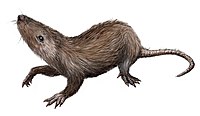Multituberculata
| Multituberculates Temporal range: Late Jurassic-Oligocene (possibly Miocene), 183–35 Ma |
|
|---|---|
 |
|
| Life restoration of Sunnyodon | |
| Scientific classification | |
| Kingdom: | Animalia |
| Phylum: | Chordata |
| Class: | Mammalia |
| Order: |
†Multituberculata Cope, 1884 |
| Suborders | |
Multituberculata (commonly known as multituberculates, named for the multiple tubercles of their teeth) is an extinct taxon of rodent-like mammals that existed for approximately one hundred and sixty-six million years, the longest fossil history of any mammal lineage, but eventually declined from the late Palaeocene onwards, disappearing in the early Oligocene, though they might have lived even longer into the Miocene, if gondwanatheres are part of this group. More than 200 species are known, ranging from mouse-sized to beaver-sized. These species occupied a diversity of ecological niches, ranging from burrow-dwelling to squirrel-like arborealism to jerboa-like hoppers. Multituberculates are usually placed outside either of the two main groups of living mammals—Theria, including placentals and marsupials, and Monotremata—but closer to Theria than to monotremes.
The multituberculates had a cranial and dental anatomy superficially similar to rodents such as mice and rats, with cheek-teeth separated from the chisel-like front teeth by a wide tooth-less gap (the diasteme). Each cheek-tooth displayed several rows of small cusps (or tubercles, hence the name) that operated against similar rows in the teeth of the jaw; the exact homology of these cusps to therian ones is still a matter of debate. However, unlike rodents which have ever-growing teeth, multituberculates still underwent through dental replacement patterns typical to most mammals (though in at least some species the lower incisors continued to erupt long after the root's closure. Multituberculates are notable for the presence of a massive fourth lower premolar, the plagiaulacoid; other mammals, like Plesiadapiformes and diprotodontian marsupials, also have similar premolars in both upper and lower jaws, but in multituberculates this tooth is massive and the upper premolars aren't modified this way. In basal multituberculates all three lower premolars were plagiaulacoids, increasing in size posteriorly, but in Cimolodonta only the fourth lower premolar remained, with the third one remaining only as a vestigial peg-like tooth, and in several taxa like gondwanatherians and taeniolabidoideans the plagiaulacoid disappeared entirely or was reconverted into a molariform tooth.
...
Wikipedia
